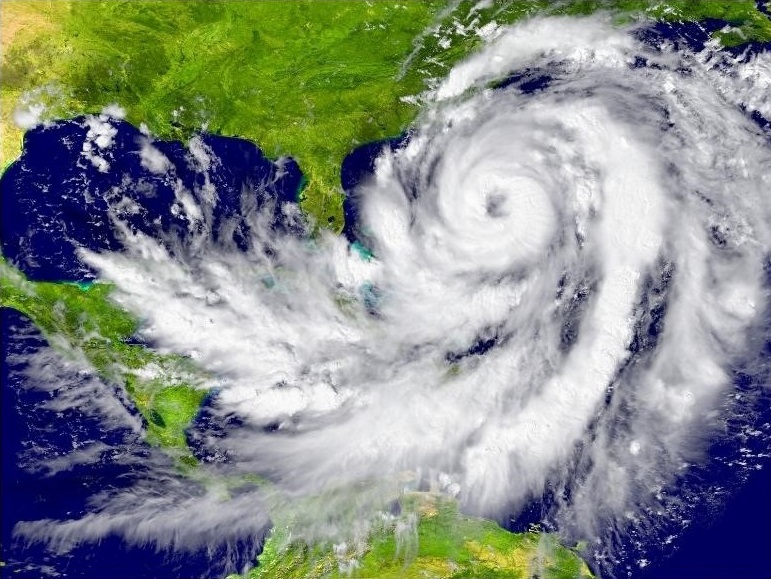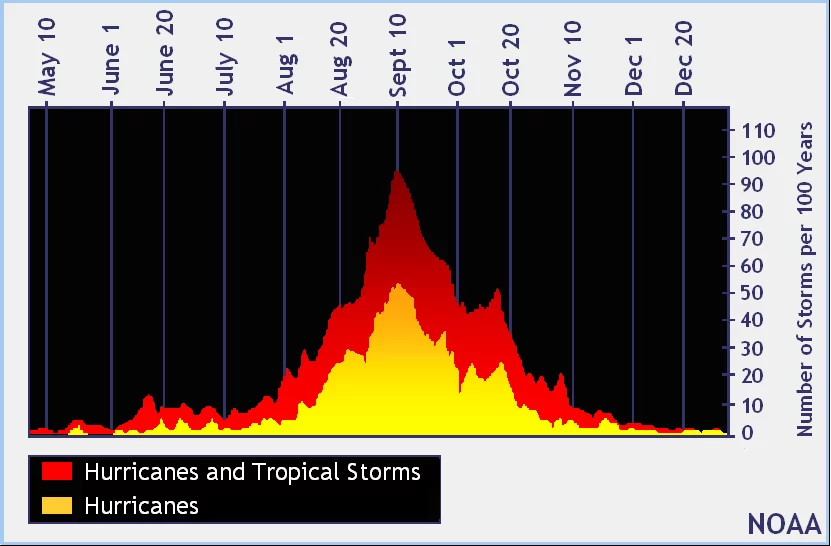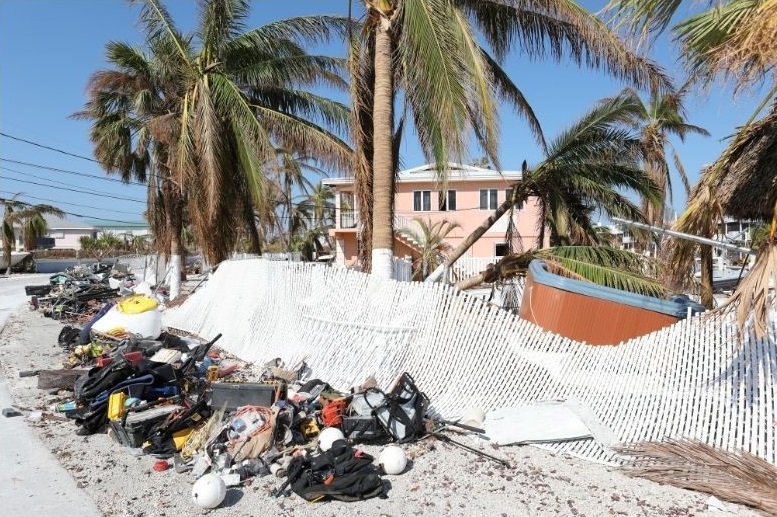
Click here for a copy of a storm readiness guide
Hurricane – The basic Facts
The Red Cross describes hurricanes as strong storms that can be life-threatening, as well as cause serious hazards such as flooding, storm surge, high winds and tornadoes.
A tropical storm gets classified as a hurricane once it sustains wind speeds of 74 mph, but, as the Occupational Safety and Health Administration (OSHA) notes, the strongest hurricanes can exceed 155 mph.
According to the Insurance Information Institute (III), the U.S. is struck by 12 named storms, six hurricanes and three major hurricanes in a typical year.
For 2022 Colorado State University has issued their Hurricane Season projection, which runs from June 1st until November 20th. It is projected that there will be 19 named storms, with 9 anticipated to be categorized as a hurricane, with 4 anticipated to be a Category 3 or higher.
How are hurricanes categorized?
As the National Hurricane Center outlines, hurricanes are categorized based on the Saffir-Simpson Hurricane Wind Scale, which gives a 1 to 5 rating based on a hurricane's sustained wind speed. This scale also estimates potential property damage.
Hurricanes that are Category 3 and higher are considered major hurricanes because of their extremely intense wind speed and potential for significant damage and loss of life. Category 1 and 2 storms are still dangerous, so you should always prepare regardless of the storm’s category.
Category 1 Wind Speed: 74 to 95 mph
Potential damage to expect: Homes could experience damage to the roof, shingles, gutters and siding; large branches could snap and smaller trees may be uprooted; damage to power lines and poles could result in outages lasting for a few days.
Category 2 Wind Speed: 96 to 110 mph
Potential damage to expect: Homes could sustain major roof and siding damage; several downed trees could cause roadblocks; power outages could end up lasting from days to weeks.
Category 3 (major) Wind Speed: 111 to 129 mph
Potential damage to expect: Homes could experience major damage, even removal of decking; many downed trees could cause numerous roadblocks; electricity and water could be unavailable for several days to weeks.
Category 4 (major) Wind Speed: 130 to 156 mph
Potential damage to expect: Homes could sustain severe damage, with the loss of roof and/or some exterior walls potential; downed trees and power poles could isolate residential areas; power outages could last weeks, causing areas to become uninhabitable.
Category 5 (major) Wind Speed: 157+ mph
Potential damage to expect: Homes could suffer complete destruction, with total roof failure and wall collapse; downed trees and power poles will isolate residential areas; power outages could last months, making many areas uninhabitable.
Hurricane watch vs hurricane warning
A hurricane watch means a hurricane is possible. Watches are announced 48 hours before expected tropical-storm-force winds (39 to 73 mph) are expected to start, so keep a close eye on the news for updates. A hurricane warning means hurricane-force winds (74+ mph) are expected and are announced 36 hours in advance. You should begin to prepare for the oncoming hurricane immediately.
Is there a seasonality of storms during hurricane season?
Hurricane season lasts from June 1st through November 30th, with the expected frequency of storms peaking on September 10th. Which does not mean that a significant event cannot strike earlier or later in the year. You should remain vigilant throughout the entire hurricane season.

The number of tropical storm and hurricane days for the Atlantic Basin spikes in mid-September.
NOAA
How to prepare for a hurricane
The following tips have been compiled from the National Weather Service (NWS), the Red Cross and the Federal Emergency Management Agency (FEMA) to help keep you safe and prepared for when a hurricane is headed your way.
Before the storm:
- Find out if you live in a hurricane evacuation area by contacting your local government/emergency management office or by checking the maps of evacuation zones(opens in new window) courtesy of Federal Alliance for Safe Homes (FLASH).
- Prepare a 72-hour emergency kit with extra clothes, non-perishable food, water, first aid and essential medicines, blankets, flashlights, batteries, a fire extinguisher, important documents and supplies for any pets.
- Consider purchasing life vests to use in emergency flooding situations.
- Replace gravel/rock landscaping material with shredded bark to reduce risk of damage from wind-borne debris.
- Trim shrubbery and cut weak branches and trees that could fall on your house.
- Check that your gutters are free from any buildup so they don’t overflow from the heavy rains, and adjust or add extensions to downspouts so that rainwater flows away from your home.
- Clean debris from around the perimeter of your house as well, as it can collect water.
- Inspect your roof, siding, foundation and basement to identify areas that need to be repaired or replaced.
- Be sure your windows are protected. Permanent storm shutters are the best option. Otherwise, have proper materials — 5/8-inch plywood — cut and ready to cover your windows.
- Reinforce garage doors — if wind blows through the garage, it can cause serious structural damage to other parts of your home.
- Develop and practice a family evacuation plan.
- Prepare a home inventory with photos of your home and personal property.
When a storm is imminent:
- Bring lawn furniture, bikes, trash cans, toys and other small, lightweight items inside or store them in a shed.
- Turn off utilities, especially natural gas or propane, to avoid fire.
- Check your carbon monoxide (CO) detector’s battery to prevent CO poisoning.
- Fill clean containers with water for drinking and consider filling sinks and tubs with water for washing in case you lose your water supply during the storm.
- Charge your cell phone and have your emergency supply kit ready.
- Cover windows with 5/8-inch plywood that’s cut to fit and ready to install.
- Fill your gas tank, refill prescriptions and grab extra cash from ATMs if still safe to do so.
- Park your car in a garage or next to a building to protect it from wind and flying debris.
- If you live in a tall building, find shelter on the 10th floor or below before the storm strikes. Consider going to your local emergency shelter if it’s safer to do so.
- If you’re told to evacuate, do so immediately. Unplug appliances and turn off utilities, if you have time and haven’t already done so.
During the storm:
- Listen to the radio or TV for information on the storm and evacuation. Try to save the battery on your phone in case you need it later for emergencies.
- Stay inside — ideally in a basement, cellar or an interior room on the lowest floor, away from doors and windows — even if it looks calm out, as the eye of the storm could be passing over.
- Leash your pets or place them in a carrier and keep them with you.
After the storm:
- Monitor local news and weather before you head outside, and if you’re not at home, return home only when authorities say it’s safe.
- Be on alert for extended rainfall and subsequent flooding.
- Stay clear of floodwater, downed wires and evacuate the area immediately if you smell gas.
- Phone systems are often down or busy after a disaster. Text or use social media to communicate if it’s not an emergency.
- Wear thick-soled shoes, long pants, work gloves and use a flashlight (not candles, in case of gas leak) during clean-up.
- Take pictures of any damage for insurance claims.
- Dry and disinfect all materials in the house to prevent mold and mildew.

Does homeowner insurance cover hurricane damage?
NOAA's Atlantic Oceanographic and Meteorological Laboratory reports that the U.S. has at least a one-in-six chance of experiencing a hurricane that will cause $10 billion in losses. And, according to the III, hurricanes and tropical storms were the second largest cause of catastrophic insurance losses between 1997 and 2016, accounting for 38.2% of total catastrophe losses.
Hurricane damage for homeowners
The damages that result from a hurricane — mostly because of the intensely strong winds and rains — are typically covered under your home insurance policy. Please contact Pineapple Insurance if you have any specific questions regarding your own policy. However, any flood damage wouldn’t be covered by your standard homeowners policy. For total peace of mind, consider purchasing a separate flood policy to keep you better protected.
Hurricane damage for condos and renters
Like homeowners policies, condo and renters insurance policies provide coverage for damage caused by the high winds related to a hurricane. The difference is in the property covered by these policies.
The property covered by a condo policy depends on the condo association bylaws. The bylaws will describe which property is your responsibility and which property is covered by the condo’s master insurance policy. Your condo insurance applies to portions of the structure that you’re responsible for in addition to your personal property. For more information on what’s covered, you can reach out to your association or contact your agent to discuss your individual unit’s policy.
Renters policies, on the other hand, provide coverage for your personal property. A renter’s policy doesn’t cover the structure, as you’re not an owner of the property itself.
Hurricane damage for cars
Most damage to your car due to a hurricane would be covered under your auto insurance policy if you opted to purchase comprehensive (Other than Collision) coverage. Comprehensive coverage provides protection for damage from natural events, such as wind, hail, lightning, falling objects or debris and flooding.
Other Important Links that you may find beneficial
· The Weather Channel
· NOAA
· FEMA
· Ready.gov: Hurricanes